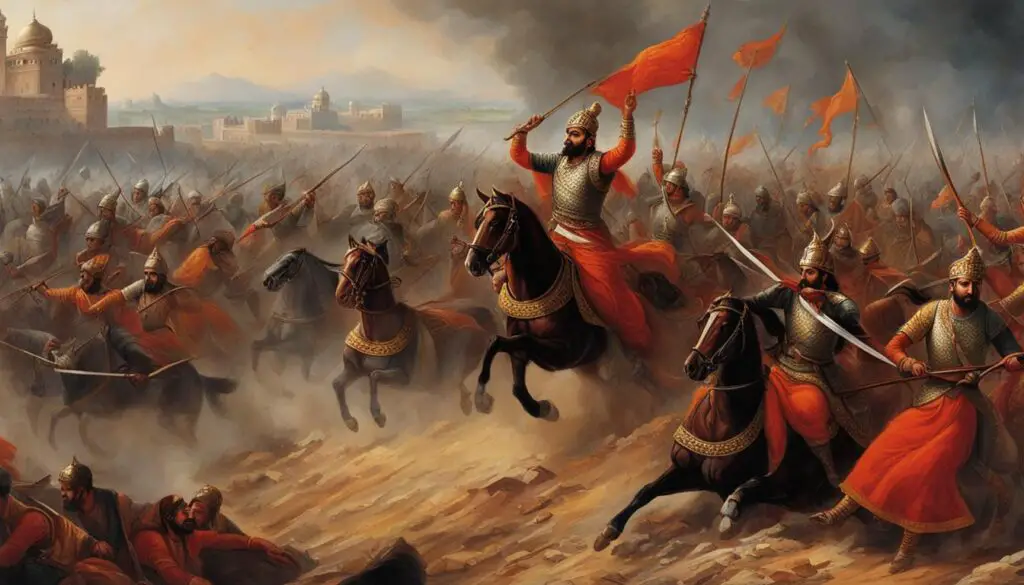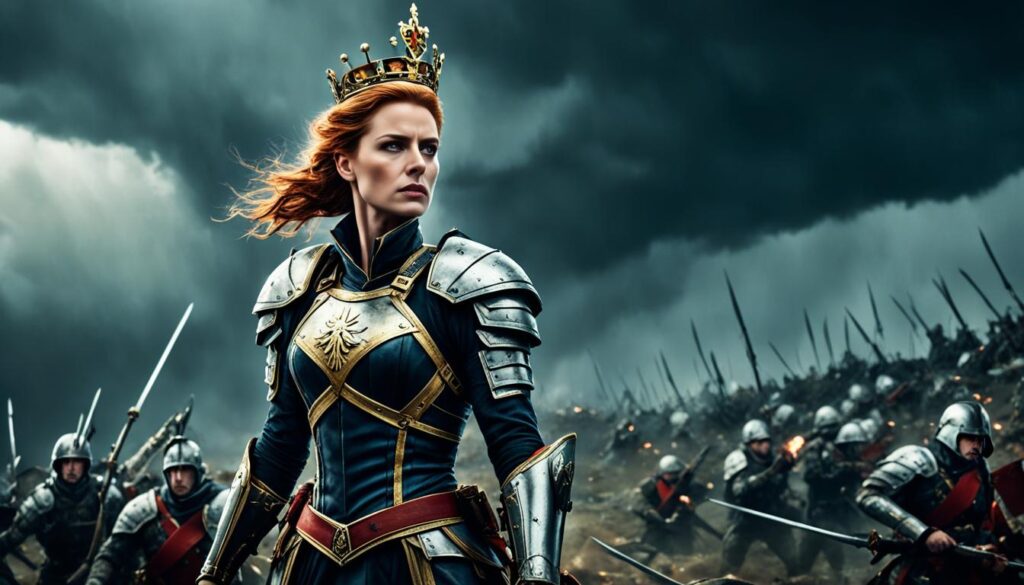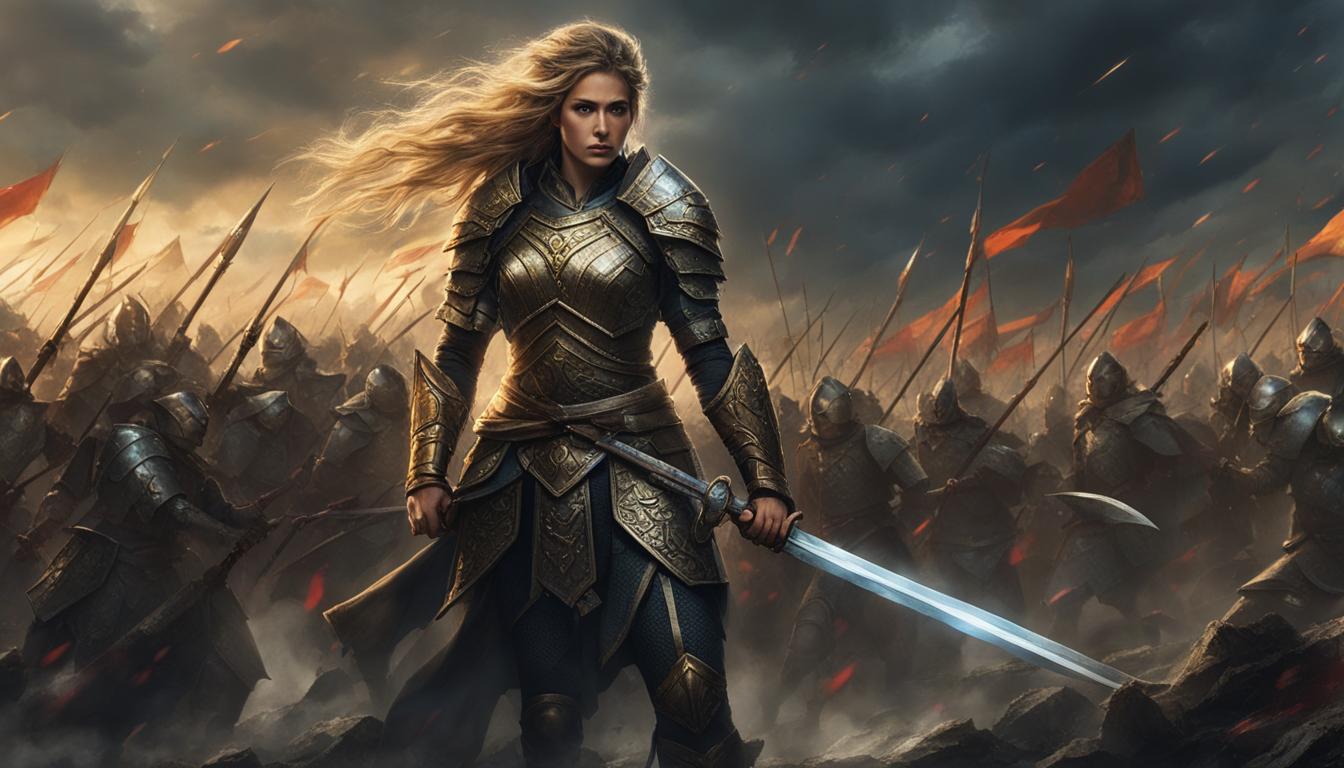Have you heard of Tarabai Bhonsle, the fearless Maratha queen who left an indelible mark on Indian history? Despite her incredible legacy, her story remains largely overlooked. Born in 1675 to the famed Sar Senapati Hambir Rao Mohite, Tarabai was trained in the arts of warfare and statecraft. She witnessed the rise and fall of the Marathas during a time of constant conflict with the Mughals. But what sets her apart from other queens and rulers of her time?
Join us as we delve into the untold story of Tarabai, exploring her remarkable leadership and the challenges she faced in shaping India’s history. Discover how this warrior queen defied expectations and left an enduring legacy that continues to inspire and captivate.
Key Takeaways:
- Tarabai Bhonsle, daughter-in-law of Chhatrapati Shivaji, was one of India’s greatest medieval monarchs.
- As regent and leader of the Marathas, Tarabai successfully resisted the Mughal onslaught and established Maratha dominance.
- Tarabai’s struggles and perseverance showcased her indomitable spirit and enduring legacy.
- Her leadership played a crucial role in the survival and rise of the Maratha Confederacy.
- Tarabai’s untold story challenges traditional narratives and highlights the strength and resilience of women in history.
The Mughal-Maratha Conflict and Tarabai’s Resilience
Following the death of Chhatrapati Shivaji in 1680, the Marathas found themselves in the midst of the fierce Mughal-Maratha conflict, vying for control over the Deccan region. Tarabai, the wife of Rajaram and daughter-in-law of Chhatrapati Shivaji, played a pivotal role in the Maratha resistance.
After her husband’s escape and subsequent demise, Tarabai took on the responsibility of regent for her son Shivaji II, assuming leadership of both the Maratha army and the overall Maratha resistance. Though grieving the loss of her husband, Tarabai demonstrated unparalleled strength and resilience.
“I am a Queen as well as a mother, and I will fight alongside my warriors to defend our land,” Tarabai declared, fueling the determination of her commanders and soldiers.
The Mughals underestimated Tarabai’s capabilities, believing that a woman and an infant ruler would offer little resistance. However, Tarabai defied their expectations by leading aggressive attacks on the Mughal forces and employing her strategic prowess.
Recognizing the Mughals’ reliance on bribery, Tarabai strategically learned from their tactics and employed similar methods to weaken their grip. Her leadership and resilience were instrumental in the Marathas’ increased power and territorial expansion, despite the initial advantages held by the Mughals.
Indian History Lesson: Mughal-Maratha Conflict
The Mughal-Maratha conflict was a significant chapter in Indian history, as the two formidable powers clashed for dominance in the Deccan region. The Maratha resistance, led by Tarabai, challenged Mughal authority and showcased the indomitable spirit of the Maratha warriors.
As the conflict unfolded, Tarabai’s remarkable efforts and leadership emerged as a defining factor in shaping Indian history. Her resilience and strategic mindset not only ensured the survival of the Marathas but also propelled their rise to power.

Maratha Resistance and Tarabai’s Legacy
The Maratha resistance, spearheaded by Tarabai, symbolizes the unwavering spirit of defiance against foreign dominance and the tireless struggle for independence. Tarabai’s courage and dedication to the cause continue to inspire generations in India.
Despite the challenges she faced, including imprisonment and rival factions, Tarabai remained committed to protecting the Maratha Empire. Her legacy as a warrior queen and her influential role in Indian history transcend the confines of time, reminding us of the extraordinary women who shaped the destiny of nations.
Tarabai’s Struggles and Legacy
Tarabai’s unwavering commitment to protecting the Maratha Empire led her down a path filled with immense struggles. Despite facing numerous depositions and imprisonments throughout her life, Tarabai never wavered in her determination to safeguard her kingdom.
After being overthrown multiple times, Tarabai took a bold step by establishing a rival court in Kolhapur, seeking to solidify her position as the rightful Queen of the Marathas. However, her ambitions were short-lived as she was once again overthrown and imprisoned, this time with her son Shivaji II.
But Tarabai’s spirit remained unbroken. In a remarkable turn of events, she managed to regain her freedom and played a pivotal role in the ascent of her grandson, Ramraja, to the Maratha throne. Despite facing conflicts and power struggles with influential figures like Nana Sahib, Tarabai maintained a regular court, diligently attending to the affairs of the state.
Throughout her reign, Tarabai issued imperative orders, conferred grants, and received esteemed Maratha leaders, all in an effort to uphold the legacy of the Maratha Empire. Her unwavering dedication showcased the strength and resilience of this formidable queen.
“Tarabai’s struggles symbolize the true essence of a warrior queen, her resilience becoming an integral part of Maratha history,” said Indian historian Dr. Raja Bhalerao.
Comparing Tarabai’s Struggles
| Challenges Faced | Outcome |
|---|---|
| Multiple depositions and imprisonments | Tarabai never lost her determination |
| Establishing a rival court in Kolhapur | Overthrown and imprisoned again |
| Participating in power struggles with influential figures | Maintained a regular court and conducted state affairs |
| Role in the ascension of her grandson to the throne | Contributed to the continuity of the Maratha Empire |
Tarabai’s struggles and enduring legacy stand as a testament to her unwavering commitment to the Maratha Empire. Her determination and resilience in the face of immense challenges continue to inspire generations, solidifying her place in Indian history as a true warrior queen.

Conclusion
Tarabai’s legacy as a warrior queen is a testament to her unflagging courage and indomitable spirit. Her leadership during a time of great turmoil in Indian history played a crucial role in the survival and rise of the Maratha Confederacy. As a formidable leader, she proved herself time and again, earning the respect and admiration of both friends and foes alike.
Her contributions in the downfall of the mighty Mughal Empire and the transformation of the Maratha state into an all-Indian Empire cannot be overstated. Tarabai’s untold story as a warrior queen continues to inspire and captivate, serving as a reminder of the immense strength and resilience of women throughout history.
From her command on the battlefield to her strategic brilliance in navigating the complexities of statecraft, Tarabai left an indelible mark on Indian history. Her legacy as a warrior queen continues to shape the narrative of Indian history, inspiring future generations to embrace their own strengths and overcome any obstacles that may come their way.
FAQ
Who was Tarabai?
Tarabai Bhonsle was a fearless warrior queen and daughter-in-law of Chhatrapati Shivaji, one of India’s greatest medieval monarchs.
What was Tarabai’s role in Indian history?
Tarabai played a crucial role in the Maratha resistance against the Mughals, preventing the disintegration of the Maratha Confederacy and shaping India’s history.
How did Tarabai lead the Marathas against the Mughals?
Tarabai took up the role of regent and led aggressive attacks on the Mughals, using strategic techniques such as bribery to her advantage. She motivated her commanders and soldiers, leading to increased power for the Marathas and the expansion of their territory.
Did Tarabai face any struggles during her reign?
Yes, Tarabai faced multiple depositions and imprisonments, but she never lost her determination to protect the Maratha Empire. Despite these challenges, she established a rival court in Kolhapur, gained her freedom, and played a pivotal role in the ascension of her grandson to the Maratha throne.
What was Tarabai’s enduring legacy?
Tarabai’s legacy as a powerful dowager and fierce queen continues to inspire and captivate. Her contributions to the downfall of the Mughal Empire and the transformation of the Maratha state into an all-Indian Empire cannot be overstated.
Source Links
- https://www.historified.in/rani-tarabai-bhonsale-the-warrior-maratha-queen/
- https://www.thebetterindia.com/121097/rani-tarabai-warrior-queen-maratha-shivaji-aurangzeb-inspiring-woman/
- https://www.esamskriti.com/e/History/Indian-History/Life-of-TARABAI,-the-Maratha-Warrior-Queen–1.aspx

